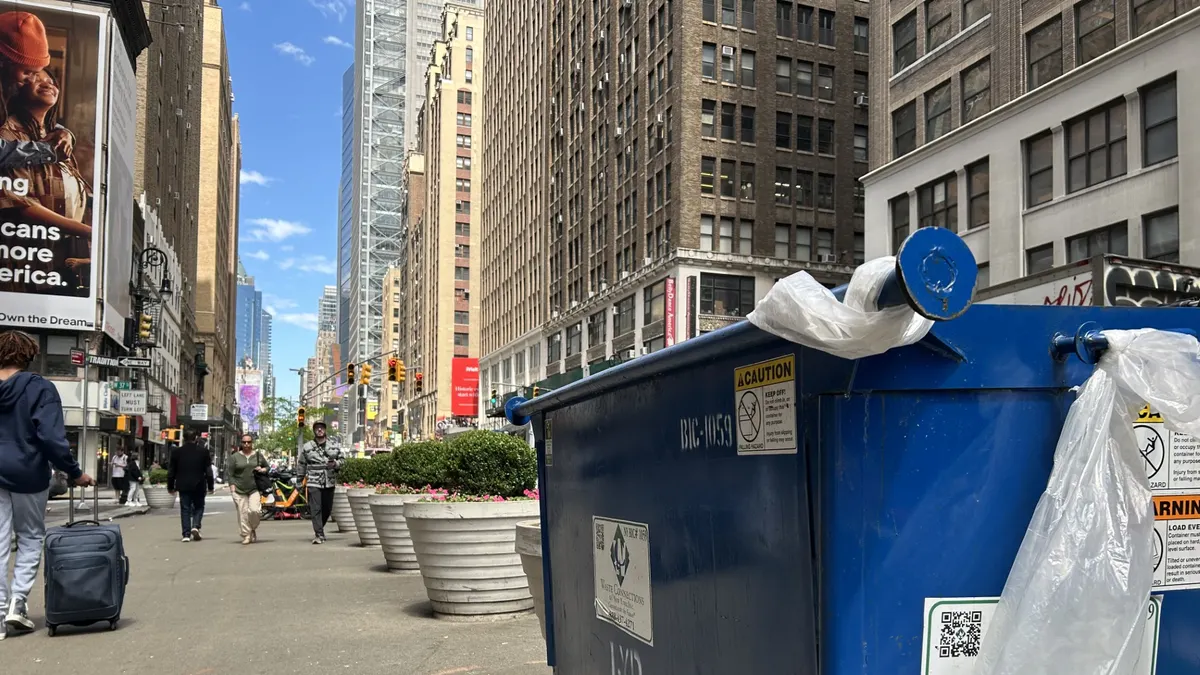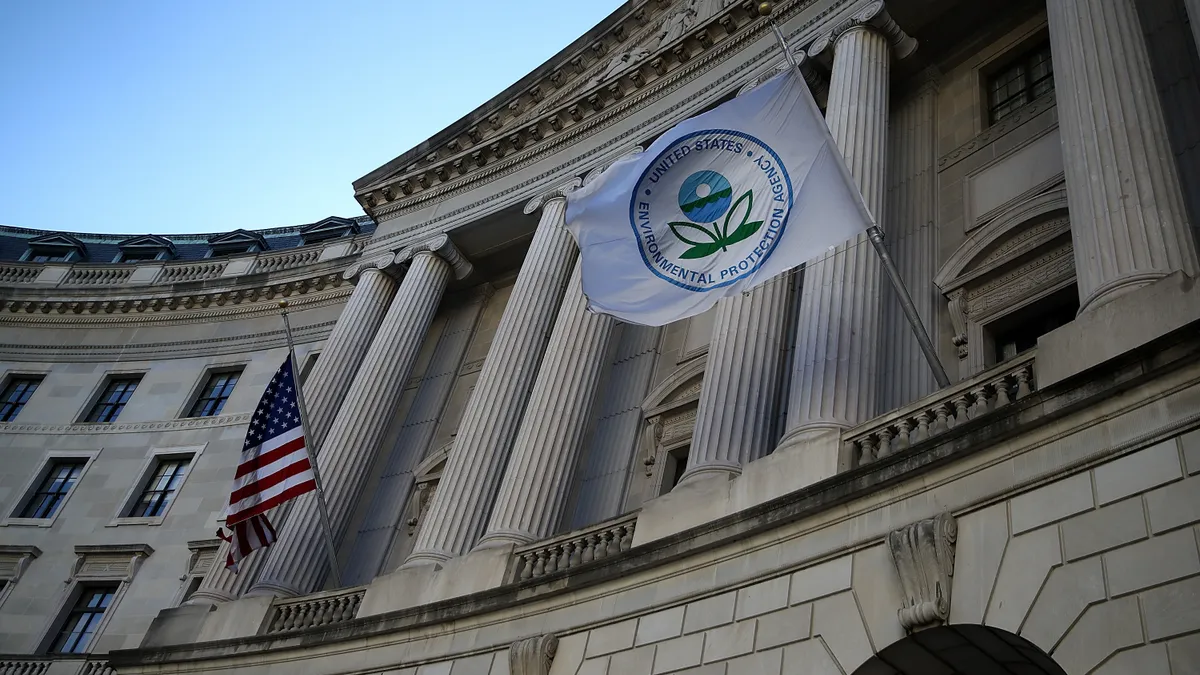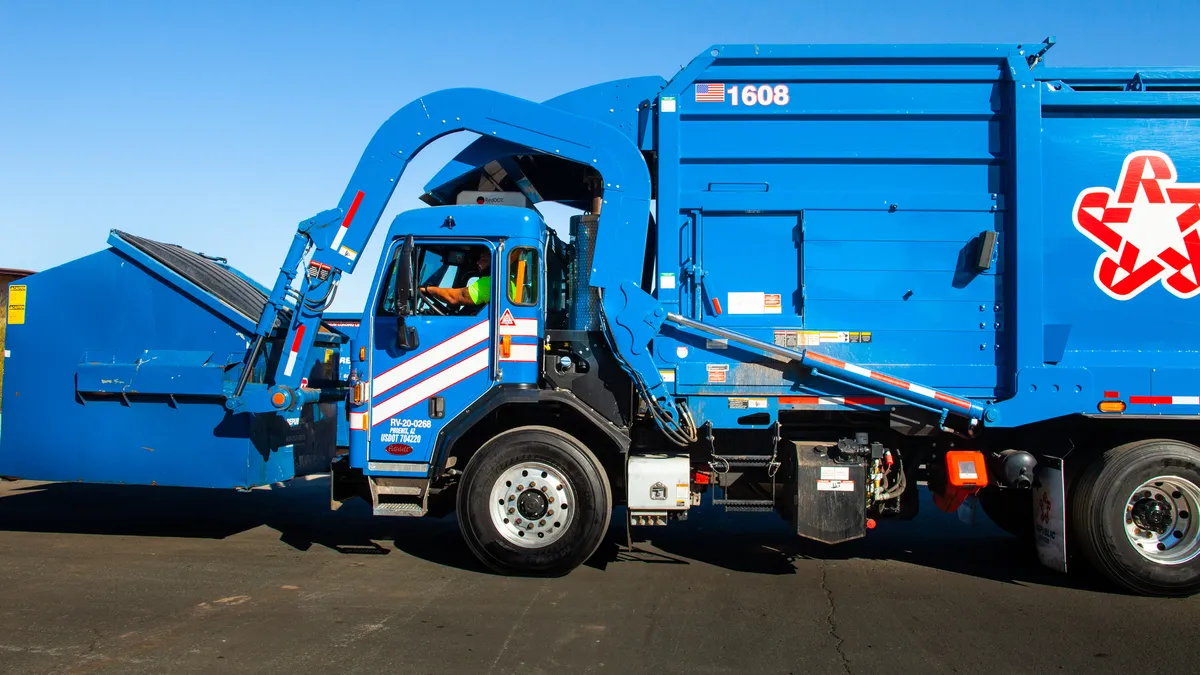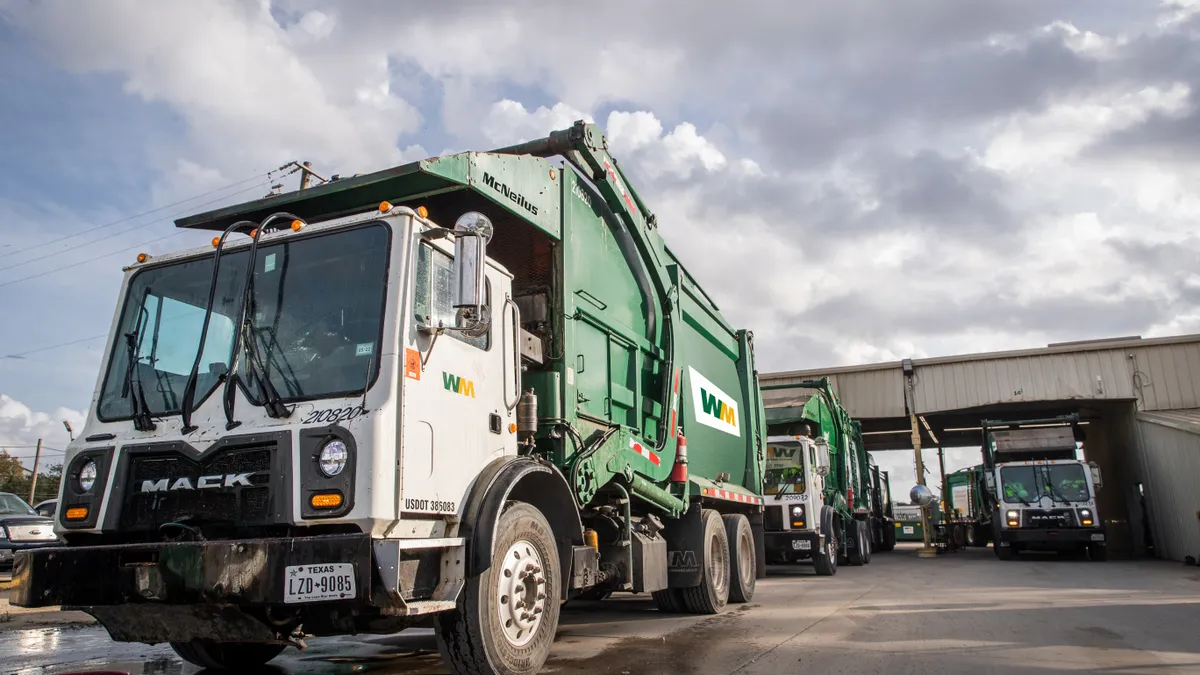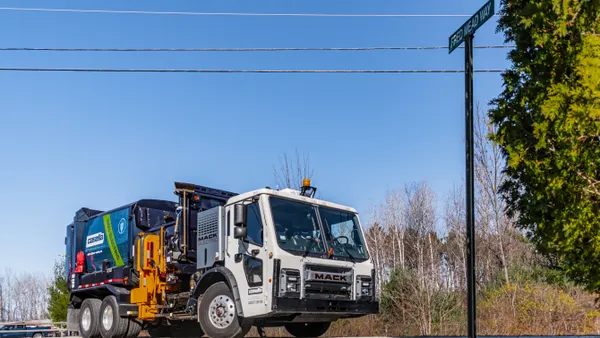Last year's elevation of John Morris to COO marked the full transition to a new generation of leadership in Waste Management's C-Suite. Now in charge of all collection, landfill and recycling operations, Morris oversees a portfolio in the midst of ongoing change – and that was before the recent Advanced Disposal merger news.
Starting out as a part-time collection worker in New Jersey for a friend's family business, Morris later joined Waste Management and has stayed with the company for more than 20 years. He rose through the ranks overseeing a complex local markets – including New York, New Jersey and California – to eventually become senior vice president of operations in 2012. Following the retirement of Jim Trevathan, Morris was named executive president and COO in 2018.
Waste Dive met with Morris during WasteExpo to learn more about his outlook on labor, landfill operations and next steps for recycling.
The following conversation has been edited for brevity and annotated for context
WASTE DIVE: Starting off on labor, did the bonuses work?
Last year, Waste Management used an estimated $70 million from its corporate tax cut savings to give one-time bonuses to more than 34,000 employees not on sales incentive plans.
JOHN MORRIS: Giving our hourly folks a $2,000 bonus, it's hard to track whether that directly worked.
What I will tell you is whether or not that specifically worked, we're finally seeing a flattening of our turnover. [A new metric] we really have dug in on is voluntary and involuntary turnover with our technicians, our drivers and other front line employees. So the $2,000 bonus certainly did not hurt, but it's hard to draw a line because we were making other market adjustments at the same time.
Whether it would have gotten worse without the bonus, I don't know. But I think that, combined with [raising] wages and some other things we've done on the benefits side that try to hold costs at bay for the employees, I think all that has certainly contributed to that flattening.
Anything else to call out, especially thinking about how the tax money is being spent? Are workers also seeing new trucks or locker rooms, like at other companies?
MORRIS: [W]e did end up buying about $250 million more in trucks than our normal run range, and so from the whole tax reform standpoint we did put that capital to work. A lot of companies took some heat for big share buybacks and that kind of thing, but we really put most of it into our people and our trucks and our facilities. Aside from just the wages and benefits, you've got to do that, especially in this environment.
During 2018, the first year after the tax cut, Waste Management spent $258 million more on share repurchases than it did in 2017.
Citing the phrase "people quit people," Morris turns to leadership as another key priority for retention.
[We're focused on] making sure that we've got the right people coming up through the ranks, that we're developing them, that we're giving them experiences across the business – instead of the ladder, kind of the monkey bars. So you might be in finance but we're going to put you in operations. You might be in sales, you might go to maintenance. We're trying to build out our talent pool at the level, so that we're building leaders when we come up and that's not somebody who's an individual contributor and has one discipline.
CEO Jim Fish and plenty of others came from outside the industry, but you rose up through the ranks as others have. Do you think the men and women on the front lines really want to report to somebody who has done what they've done?
MORRIS: I think historically the industry has probably been guilty of that. People were brought up in the industry, they move up the ranks – and I don't mean just the public companies, the private companies, too. I think it's changing, though. When it's all said and done I'm not going to hop in that compactor and drive it in a landfill. Those days are gone for me. But the person who's going to get in it needs to know that I respect what they do, and I'm going to treat them the right way. So I think, as time goes by, there's less and less of "you had to start hanging on the back of a truck." It's a good story for me, and for others who started at the front line for one reason or another and were able to work their way up.
The reality is the fact that I started driving a truck gives me a perspective. But it's not why I'm here today. It's because I had great people who mentored me along the way and taught me more about how to be a good leader and a good business person. And I think that's what we're focused on. We've got people, and the diversity among our talent is changing.
Morris goes on to talk about how his younger sons are an example of rising generations looking for "purpose-driven" work, with strong leadership, and why he sees Waste Management as fitting the bill. At the same time, CEO Jim Fish recently mentioned how he received multiple questions from students at a University of Chicago event about the environmental profile of landfills.
What are you hearing in terms of the cultural conversation around landfills and what that means for the business?
MORRIS: You know, its funny, I have these discussions with friends, family, and business people, etc. about what landfills really are. If you step back, people referred to them years ago as dumps ... If you spend some time really talking to the technical people who engineer these, construct these and run these, they're a continuous civil construction project that doesn't stop 'til the landfill's over.
Morris notes that Waste Management has 130 projects converting landfill gas into electricity or fuel, some of which can be sold into the pipeline via state or national credit pathways.
So, with regard to landfills, listen they're not getting any cheaper to construct. They're not becoming any [easier], and they're becoming more and more difficult and costly to manage.
It seems like leachate expenses are up for everybody these days.
MORRIS: One of the challenges I think the industry is facing is for many years a lot of the publicly-owned treatment facilities were very willing to take the industrial wastewater or leachate. What we're finding now is that, we built a handful of these plants ourselves because the outlets for that – and frankly the transportation of the liquids – is becoming more and more challenging.
What do you see in terms of regulations evolving, whether it's a future carbon tax, or implementation of existing emissions guidelines? Are the screws tightening on landfills in your sense?
MORRIS: The challenge in landfills is obviously siting them, operating them, constructing them. The cost has gone up. We have seen, obviously, some challenge with the leachate and industrial wastewater piece.
If you look at states where we have a lot of landfills – Pennsylvania, California, Washington, Oregon – West Coast, East Coast is generally where you see the restrictions to be a little tighter. Things start on the left coast, then migrate to the East Coast and generally then they migrate to the middle – whether it's around regulation, whether it's what's going on with recycling and diversion and sustainability.
The good news for us: it generally doesn't happen in one fell swoop across the whole portfolio of assets. So, we've got an opportunity to address it in a particular region. But, if you look at the way our landfills are operated from place to place, California you have no leachate issue. Pennsylvania, big leachate issue. Florida, big industrial wastewater issue. So, a lot of it has to do with the waste streams you're taking in at these facilities.
Morris explains that different types of disaster debris – from fires in California to flooding in Texas and Florida – also affect landfill management practices.
If you go to our Gulf Coast landfills, we obviously service a lot of the petrochemical industry – a lot of the industrial producers – so how we have to handle some of their waste is different from how we have to do, say, in Minnesota.
Some of the waste-to-energy companies feel bullish lately, they think the future is going to turn in their favor – over the next 10, 20 years – due to the story around energy creation vs. landfills, climate change, concerns around emissions. Do you think landfills are still at it 20-plus years from now, or is the tide going to shift?
MORRIS: We owned [Wheelabrator], one of the larger waste-to-energy players, that we sold five years ago or so. It's a solid business. They have some nice assets in the space. If you look at where the plants are generally located, though, they're kind of in the Northeast corner and then a smattering around the country down the East Coast. They're not cheap to build either. And one of the challenges is getting one permitted.
I think the last plant we permitted or constructed was probably around 1990. [When] we sold Wheelabrator we were building a few facilities over in Europe.
The reason I bring Europe up – different model over there. Because of the rates they've put in place, they've made permitting or disposing of waste so expensive that they want to drive it to the waste-to-energy companies ... Whether or not they're going to migrate back to the U.S. and become another option? Only time will tell.
Morris mentions that Waste Management has decades of remaining capacity at its current portfolio of sites — noting that the potential Advanced Disposal deal could bring in upward of 41 new sites (some of which he anticipates may not be kept) — and is looking to acquire more. The recent approval of an expansion at the Great Oak Landfill in Randolph County, North Carolina is also mentioned as a success.
What made Waste Management want to invest in the new Chicago MRF, as the "recycle plant of the future," given it's not in a market with as many regulatory drivers as other states?
MORRIS: We have two plants out there and we were at the point where we needed to make some investments anyway. And we were looking for a platform where we could do something different around recycling.
What we're really trying to do with the plant of the future is lower our costs. And how are you going to do that? When you look at the labor that we put into recycling facilities – it's hard to come by and there's a lot of turnover.
So, if we can solve a labor shortage we have, and get the costs down, that was part of the premise of going into this facility. It's going to be expensive. I don't know if it's 2x but it's in that range of a traditional MRF, but we're hoping that we're going to get somewhere around 40% of the labor costs.
Holding up a plastic bottle as an example, Morris mentions how the process will be "much more mechanized."
Now we're going to put a robot in, or an optical sorter, or a ballistic separator, mechanize it and pick out the bottle itself. So that solves a contamination issue. Because if you pick what you want, then, in theory there should be very little, if any, contamination. We're obviously going to solve a labor problem. And I think it's going to give us, quite frankly, some variability in the way we run the plant as markets change, which they do, between all the streams that we get. If you have robotics and a lot more mechanized systems in the plant, it becomes more pliable. If there's a grade of plastic that we're not recovering because there's no market, and then there is one, in the plant we're describing you can start to extract that.
Morris adds that the facility may offer opportunities to capture more thermal value out of residual material and says increased demand from manufacturers for recycled content will be a critical factor in reorienting markets. Morris explains how Waste Management's new approach to raise costs and reduce commodity risk is working in the meantime. The company's recent Q1 earnings report showed recycling revenue up YoY, despite commodity pricing being down.
The new Chicago project is expected to begin taking material by Q4, and labor efficiencies will be a key area to watch once the facility is online.
It will be people watching a series of computer screens instead of watching belts ... I think that is a much more of a desirable job. And that's a theme, not just in recycling – automation. One of the things we're doing on the people first [approach] is looking at these jobs long-term, whether it's in the MRF, whether it's in a collection vehicle or heavy equipment.
What are these jobs going to look like in 5 or 10 years and who are we going to attract? A lot of what we're doing with the MRFs and automation [including the Caterpillar landfill pilot] is around making the business more efficient, and it's also trying to plan for the future to make sure that we're attracting the right people into the industry and into the company.








